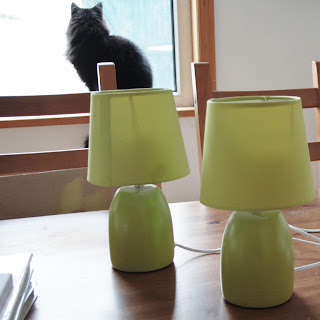| Just because I'm incapable of writing about animals without a super-cute picture |
In my early days of crocheting I had the vague idea that, despite being a vegetarian and animal lover, using wool from sheep was OK as the sheep weren't harmed. I imagined them roaming around the countryside freely (like the sheep you see all over the mountains of North Wales and the Lake District), being rounded up for a haircut once every few months, then happily ambling back off for a bit of grazing.
Of course, when I think about it now, it seems really naive to have ever thought that an industry as huge as the global wool industry would be this humane. At the time, I just didn't really put that much thought into it, but as soon as I did, I stopped buying sheep wool.
I don't have a problem with wearing wool from animals at all, but I do have a very big problem with the way commercial wool is obtained. If you want to read up on the treatment of sheep in the wool industry, the Vegetarian Society is a good place to start. Peta also have some useful info.
I try not to bring upsetting facts into this blog, partly because I hate having distressing images and information sprung upon me without warning and partly because I believe people should find out things for themselves and make decisions within their own moral framework. I do think at the very least, however, we should be aware of what we're wearing or crafting with.
Briefly:
- 70% of the wool used in clothing comes from Australia, where the practice of mulesing is still common
- Around one third of UK wool is skin wool, taken from slaughtered sheep, mainly lambs.
It was an easy decision for me to stop buying wool as there was no way of telling where it came from or how it was obtained. Although there are plenty of alternatives out there, I've been looking for cruelty-free sheep wool for a couple of years now and it's depressingly difficult to find. I am sure there must be plenty of specialist independent companies, humanely shearing their sheep and giving them the best possible life, but I've only found a handful. I'm personally not comfortable using wool from sheep destined for the plate, so I've left out suppliers whose sheep fit into this category but I know there are many British farmers out there who give their flocks a good life before slaughter.
If you want to dress and craft cruelty-free, here are some of the options:
Cruelty-free wool
Based in Wisconsin, Homestead Wool sell dyed/undyed/spun/unspun wool, refer to their sanctuary as a 'retirement village' and introduce you to all their animals. Can I just say, I LOVE this website?
Insouciant Hair are another US company who sell yarns from rescue sheep.
Selling yarns via etsy, Wild Wool Farm not only allows you to see pictures of the sheep or goat your wool has come from, but also to 'adopt' them for a month.
The Farm Animal Sanctuary, based in Worcestershire, sells fleeces from rescue sheep ready to be spun into yarn. This really appeals to me but I haven't got a clue how to start with spinning....one day maybe...
Finally, they don't sell yarn, or house sheep, but I came across The Goat Sanctuary during my research and had to mention them! I'd never heard of this place before but it's now on my list of places-to-visit-on-a-random-Saturday (if my poor, long-suffering boyfriend agrees).
Clothes
I haven't bought anything from here personally, but Izzy Lane is proof that it is possible to run a successful business based on compassion for animals. The sheep in Izzy Lane's flocks live out their natural lives in a sanctuary, cared for by shepherd Ernest.
The same flocks also provide wool for The North Circular. While their handknitted goods are way out of my price range, I admire the ethos behind the company and think it's great that they've received so much press attention.
Alternatives to sheep wool
All yarn stores and craft shops will carry alternatives to sheep wool. Here are the most common:
Cotton
Cotton is great for crocheters and I use it for a variety of projects. It's smooth, strong and available in every colour imaginable so it's brilliant for home decor and accessories.
Tencel
Tencel is made from wood pulp and is fully bio-degradable. It's wearable, drapes nicely and is generally considered more environmentally friendly than other materials. It's also said to be “soft as silk, strong as polyester, cool as linen, warm as wool, and as absorbent as cotton", quite an endorsement!
Bamboo
I love working with bamboo yarn but it can be hard to find yarn which doesn't also contain wool from animals. When I do find 100% bamboo, or a bamboo/cotton mix, I snap it up! Bamboo is gradually becoming more popular and easier to find. The picture below is of a bamboo/tencel mix and shows the lovely sheen natural fibres can produce:
| Bamboo/tencel mix from Etsy |
Linen
Linen is made from flax and when knitted or crocheted can make really luxurious clothes and accessories. Linen usually becomes softer the more it is worn making it ideal for cardigans and jumpers.
Synthetics
Aah, the knitter's enemy. Acrylic, nylon and polyester yarns can be bought from around 99p a ball and can be very unpleasant to work with if you buy the really nasty stuff. There are some decent synthetic yarns on the market, however, so don't be put off. A lot of big, chunky acrylics can be really soft and enjoyable to work with, giving a great end result. Similarly, some of the pastel coloured acrylics meant for baby clothes are lovely and soft. When buying synthetics, it's generally best to buy in person so you can see what the yarn looks like close up and avoid that horrible cheap look!
Banana yarn
Banana yarn has similar properties to silk and is often dyed in an array of vibrant colours. It can look really dazzling and many banana yarns have a luxurious sheen making them a great choice for a statement scarf or accessory.
| Banana yarn image from Pinterest |
--------------------
While I'm happy with my cotton and bamboo most of the time, I would like to have more options when it comes to cruelty-free wool. I'd love to buy wool knowing it came from a happy, well-looked after sheep who was humanely sheared and wasn't going to be sent off to slaughter. If you know of, or come across, any companies or individuals who sell cruelty-free wool, please let me know!
Jenny
x












































